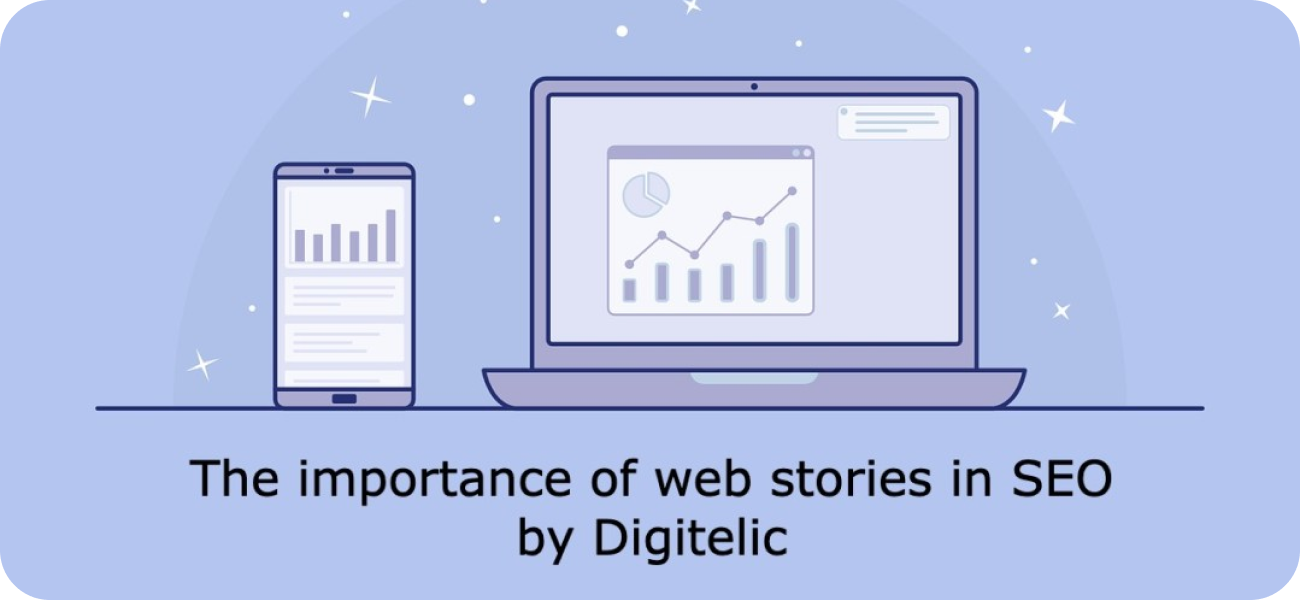


There are several advantages to using web stories in your online
presence. They are a simple approach to reach a new audience and
increase interaction. And they work wonderfully for brand marketing
and increasing your CTR. However, one component of web stories that
is sometimes ignored is the value they provide to your SEO. In this
post, we'll look at the importance of web stories in SEO and how they
may benefit you.
SEO is an abbreviation for Search Engine Optimization. It is the
method through which Google filters and sorts websites to determine
which ones should appear in search results. Websites with strong SEO
rank on the first page of search results for practically all related
searches. As you can expect, having a strong SEO ranking is a top goal
for most businesses.

Having good SEO ratings is, unfortunately, easier said than done.
Google has developed and continues to refine the SEO algorithm,
making it increasingly harder to "hack." The days of simply finding a
couple of niche keywords and hoping for the best are long gone.
Today, SEO administration is a serious issue that frequently demands
the assistance of a professional. Your SEO will be affected by all parts
of your website, from the material you use to the way it is laid up.
As a result, climbing the SEO ladder is sometimes a difficult,
long-term undertaking. Even seasoned SEO managers are taken aback
by how powerful web stories may be in this specific project.
When Google caught up on them, web stories were thrust into the
marketing limelight. Previously, social media sites were the primary
destinations for narrative material. Facebook, Instagram, and, for a
while, LinkedIn all pushed story material in the same way. While
sharing stories on social media sites is certainly valuable, it does not
fully harness the potential of online storytelling. It also has no
noticeable impact on SEO.
When Google took up on web stories, they quickly became the most
popular marketing material. Aside from giving them significantly more
capability than they had on social networking platforms, Google
assured that web stories provide a significant amount of SEO value.
After all, it was and continues to be in Google's best interests for
consumers to use web stories. What better method to inspire them than
to tie SEO advantages to it? For a while, web stories were even
considered an SEO trick. Even with a mediocre web story, you may
easily land up on Google's first page. While this is no longer the case,
web stories continue to be the most popular type of SEO-friendly
content.
One of the key reasons why web stories are now so effective at
enhancing SEO rankings is that they are not widely used. Even
seasoned marketing managers are often unaware of the value that web
stories can provide. Even if people come across them on websites,
they tend to dismiss them as simply another type of Content. As you
can expect, this is the incorrect strategy. It's also one of the main
reasons why web stories are now one of the most powerful SEO tactics.

When it comes down to it, SEO is all about defeating your competitors.
The very few individuals who post about your business, the simpler it
is for your content to stand out. Web stories are a new playing field for
SEO because of the way Google is set up. As a result, there isn't much
competition. Yes, there are businesses who use web stories effectively.
And, in order to have no competition, you must run a specialised
website. Web stories, on the other hand, are a piece of cake when
compared to regular SEO competition. It's difficult to say how long
this will be the case. However, if you want to make the most of web
stories, you must understand that time is not your friend.
To get the benefits of web stories in SEO, make sure they are
optimised. As previously said, SEO is fundamentally an algorithm.
And, as such, it has regulations that you must follow in order to receive
higher ratings. If you're already familiar with Google SEO, this
shouldn't be too difficult. Many of the standards and criteria that apply
to conventional content apply to web stories as well.
Google is attempting to filter for quality material more and more with
each new version of the SEO engine. And, although you may still get
away with fluff content in blog posts, there is just no place for it in web
stories. As a result, when developing web stories, strive to prioritise
quality as much as feasible. Make sure the material you create is
one-of-a-kind, relevant to your company, and appealing to your clients.

Every web story needs a title. While it may not appear in the
conventional manner, it will be included in SEO. As a result, make
certain that you give it your whole attention during the creation
process. A typical title is no more than 70 characters long. You must
provide a clear and exact sense of what the web story is about with it.
If you have any further information on the web story that you want to
share, keep it for the page attachments. This might be a blog entry.
Alternatively, a written explanation paper.
Google places a high importance on making your content easily
accessible. So, if you're going to use visual content in your web stories,
be sure to include alt texts or video explanations to back it up.
This manner, persons who are blind or deaf may still enjoy your
material. Even if you don't believe your content need accessibility
improvement, keep in mind that it improves your SEO. Even if the
great majority of your audience will not view the alt texts or video
descriptions, keep in mind that they do assist.
You don't need to do much with metadata. You just need to follow the
Web Stories rules for Google Web Stories. The standard data for the
rest will be as follows:
The meta title.
Description of the meta.
Protocol for Open Graph.
Data that is structured.
Twitter business card
After you've created web stories, you'll need to validate them with
AMP. This manner, you can ensure that your HTML is proper. And
you will offer your validated stories more SEO value than unvalidated
content.
Because web stories will be part of your online presence, they must be
included in your XLM map. It's a good idea to include appropriate
tags as well. You'll be able to better explain your web stories this way.
Another reason web stories are so helpful in SEO management is that
they are simple to incorporate with existing material. This may come as
a comfort to some, since marketing executives are often concerned
about their existing content being overshadowed before investing in
web stories. After all, if you've spent months, if not years, developing
your SEO with normal content, you'd be a fool to abandon it now.
Fortunately, web stories provide an easy approach to not only promote
new content but also renew existing content.

Second, web stories may be included into your content. Web stories,
in addition to basic photographs or videos, may become a regular
feature of your blog entries. You may also seek for ways to incorporate
web stories into existing blog entries, renewing them. Finally, web
stories may help link separate blog entries and highlight how one
explains the other better.
To begin, you may utilise web stories to promote older content. In this
case, web stories can serve as a preview of the content and help
persuade users to read it. The best approach is to start with the most
popular posts. More than likely, there is a reason why those specific
postings get the best results. If readers return to them again and again,
it is most likely because they are well written and fascinating. As a
result, start slow and utilise your first web stories to increase those
postings. When your audience begins to appreciate your web stories
and the pieces they link to, you may begin to connect them to less
popular topics. Overall, there is no disadvantage to linking your blog
content to your web stories. The only issue is choose which blog articles
to link to first.
When it comes to coming up with ideas for web stories and integrating
them with your existing content, we highly advise you to stick to tried
and tested SEO strategies. Investigate keywords. Analyzing online
traffic In comparison to competition. All of them are applicable to web
stories. If necessary, you may also utilise them for backlinks and social
media postings. So, rather of depending just on narrative format on
social media, attempt to discover all of the situations in which web
stories may be used. Then, use SEO strategies to such cases.
We've stated it before, but given how vital it is, we'll say it again. Once
you've connected your web stories with your content, you must submit
a new XML map. The only way to genuinely profit from your
integration's SEO benefits is if Google is aware of it. The only way to
be certain is to submit an updated XML map.
Last but not least, it is critical that you track the success of web stories
in SEO. To do so correctly, we recommend that you first install a
Google Analytics Tracking code. It is also recommended that you
provide a Twitter app ID and a Facebook app ID. Google Analytics is
the bare minimum tool for tracking the performance of web articles.
You may also use Data Studio, which offers a specific Web Stories
Insight dashboard. Other third-party solutions for measuring web story
metrics are available, but you must first ensure that they are AMP
supported.

There are two key reasons why tracking web stories is important. To
begin, you must clearly define their significance to your digital footprint.
Because integration is highly recommended, you should see the results.
Especially if you want to develop both normal marketing material and
web stories at the same time. Second, you must define what your online
articles are doing well and what they are not doing well. Good audience
interaction does not always imply higher retention rates, or even that
your Webflow SEO is improving. And, if you want to use web stories
effectively, you need understand what you can do to improve them.
It should be quite clear by now that leveraging web stories in current
SEO is something to think about. If you've worked with SEO before,
you're well aware of how effective a new tool can be. And, despite the
fact that Flykup makes it very simple to create web stories, not many
marketers use it. As a result, the sooner you begin integrating web
stories into your online presence, and hence into your SEO, the better.
By joining up for a free trial with Flykup, you can begin telling your
users their Web Story right away.
Flykup is a B2B Web Story platform whose offerings allow any website
or app to publish their own Web Story content or leverage the Flykup
content library, increasing engagement and conversions while also
giving them access to their own traffic data and the ability to monetize
through ads. Flykup mission is to empower the open web with tools
that enable Stories engagement outside of the walled gardens.